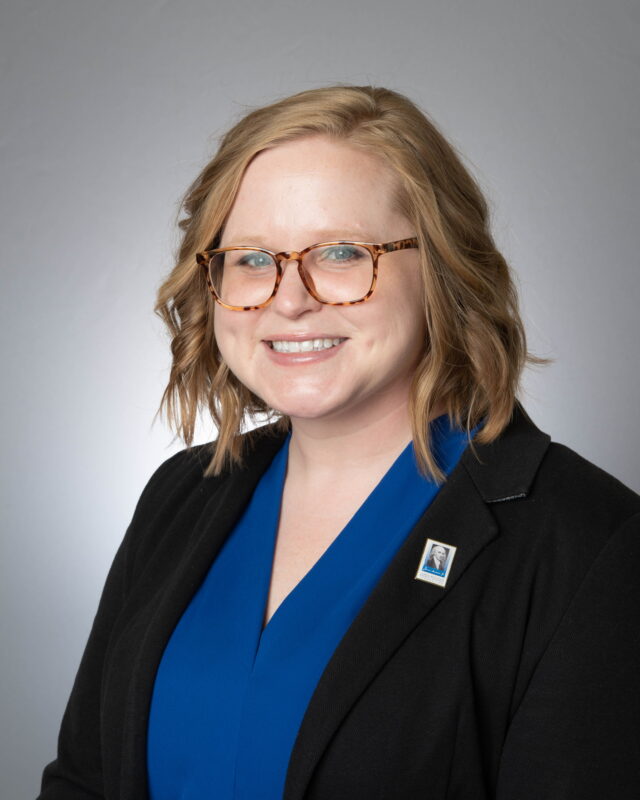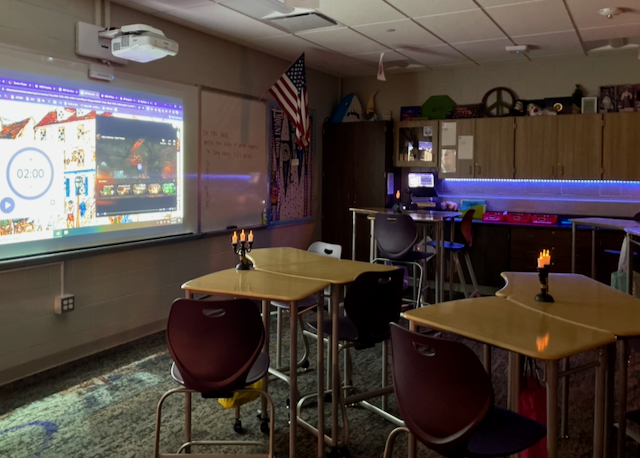Meet Our Teachers
Marilyn Orseno

Marilyn Orseno was named 2023 Ohio History Teacher of the Year by the Gilder Lehrman Foundation. She also placed on the short list of Teachers of the Year considered for the National History Teacher of the Year award. Orseno graduated from the Master of Arts in American History and Government (MAHG) program, which extended her ability to teach primary document analysis. An earlier Masters from Cleveland State University prepared her to give students experience in document collection and curation. Both degrees prepare her to “put history in action.” Orseno teaches American History and American National Government at North Royalton High School near Cleveland.
Immediately after finishing my undergraduate degree, I entered a Master’s program in history at Cleveland State University, through their Center for Public History and Digital Humanities. Students in the program collect, curate, and digitize primary documents of local Cleveland history. We conducted interviews of older citizens, gathering oral histories of earlier times; transcribed these; gathered photos, and so on. Much of our work was used to build content for the Cleveland Historical App, which gives historical background on sites and landmarks around the city. One of my biggest accomplishments was locating a group of murals of German people dancing, originally made for Herman Pirchner Alpine Village. Pirchner himself held a world record for the number of beer steins he held without spillage while sliding across the floor of his German-themed restaurant, clad in lederhosen. I found the murals displayed on the exterior walls of several buildings at a community college located 15 minutes from my house. We took photos and added them to the app.
After completing my degree, I substitute taught for a time before being hired by North Royalton High School about seven years ago. I currently teach College Credit Plus (CCP) American National Government and Advanced Placement US history. I am able to offer the CCP class due to the James Madison Fellowship, which funded my studies in MAHG, where I got an excellent grounding in US government. Now I teach both APUSH and, through CCP, American National government.
Two Kinds of History Education
There are so many different ways to approach historical study. I’m fortunate to have been educated in both a research-oriented program and in the MAHG program, which focuses on the careful study of key primary documents, many of them well-known and frequently cited in histories. Having both experiences helps me navigate both in my classroom. To teach history and government well, you need a thorough grounding in primary documents, which MAHG gave me. Yet I can also give students the experience of compiling and curating primary sources on which the study of history is based.
Most teachers, during their first years in the profession, are constantly wondering, “Am I doing this right?” I feel like I have had great preparation, as MAHG introduced me to many of the documents I now use and helped me figure out how to best analyze each. I can confidently field questions about the documents; if I don’t know the exact answer, I point students in the direction of an answer.
Simulations and Debate Put History In Action
I try to make my classroom as student-focused as possible. Many people stereotype history as the inactive pursuit of esoteric knowledge about events of little relevance to our own times. I challenge the stereotype of inaction by changing the prefix into a separate word: I teach history “in action.” History is something you can actually do, see, and discover while using the skills of document analysis, making connections, and critical thinking.
Just as if they were in a MAHG class, my students are expected to arrive in class having carefully read the primary documents I assigned. Then we take that content and do things with it. We look at documents from different points of view, engage in debates, or compare the differing perspectives of two documents and try to find consensus. I want my students to have the experience of questioning each other’s ideas and interpretations in a safe space, so that in later life, they’ll be better prepared to handle disagreements. I love facilitating the building of those communication skills.
Sometimes I invent historical simulations. In my CCP government class, we’re studying the ideas on self-government circulating among literate Americans at the time of the Revolution. I introduce the lesson to students by asking, “Have you ever seen a TED talk?” Most have, and we talk about the novel ideas TED speakers present. I ask, “In the colonial era, where would Americans hear about new ideas?— besides in newspapers? Where would they hear all the hot gossip? Someone says, “The tavern!” I tell them they will each prepare a “Tavern TED Talk.”

They are “privileged commoners” who can read (there were high rates of literacy in late colonial America) and have gotten their hands on books of political philosophy from Europe. I give them excerpts from Montesquieu, Voltaire, Rousseau, Algernon Sidney, and Locke, telling them, “The ideas of one of these authors really get you thinking. You can’t wait to share them with your friends down at the tavern. Put together a two-minute synopsis explaining who the author is and what he said. Remember, you are talking with friends, trying to get them as excited as you are. Also, you’re in a tavern—there will be background noise to contend with.” Additionally, students have to turn the ideas from their document into a limerick-style poem to help the tavern-goers remember what they said. I try to recreate the dimly lit and noisy tavern scene in my classroom with crowd background noise on the day they are set to present. Students really get into it, putting the philosophical ideas into analogies their friends will understand and reciting the rhymes, while their classmates pound the tables when then hear ideas they like.
Primary Document Analysis Makes Students Slow Down and Think
What’s cool is to watch them prepare their talks. They have to really slow down and think about what they will say.
We also spend a lot of time analyzing several of the Federalist papers that I studied in MAHG, along with excerpts from the Antifederalists. Sitting with those arguments and thinking about them helps them realize that the Constitution was not a framework we made in a hurry. Every provision was carefully considered, at a time of stress, when no one was sure the nation would survive. I also assign Edmund Burke’s speech “On Conciliation with the Colonies,” which I studied in a MAHG course; I remember thinking how perceptive Burke was in noting the reasons the colonists might want to separate from Britain. They weren’t just being stubborn; they had a vision of a better life.
I’m very thankful for those binders of documents we made up for our MAHG classes. The summer after I completed my degree, I returned to campus to take Jeff Sikkenga’s class on the Fourth Amendment. From it I drew excerpts of judicial opinions on the evolution of the right to privacy, using them for a midterm in my CCP government class. I based it on an assignment Sikkenga gave us. I told the students they were legal advisors to a school that wants to ban cell phone use on campus. Officials at the school reason that social media harms adolescents. If a student were found to be carrying a cell phone, it would be seized and searched for harmful material. Based on the documents, could the school implement such a policy without running into constitutional issues? I tried to make a prompt that Chat GPT would have difficulty answering.
In History “Lab,” Students Practice Document Collection and Curation
My MAHG work provides documents and ideas I use through much of the school year, but in the last month of the APUSH course, I use my background in local history research. Students take the APUSH test in early May, but school doesn’t end until June. So, I reached out to our local Historical Society and was able to take donated letters from World War II and have my students digitize, transcribe, and provide context to what they were reading. The letters were saved by a Royalton resident who was in correspondence with his high school friends who were all experiencing the effects of war.
I wanted my students to develop an appreciation for collections management, so I organized a Zoom meeting between my students and the archivist of the World War II Museum in New Orleans. She explained archival work. Then each student chose a research focus—a theme related to the letters: perhaps defense industries in the Cleveland area; how minority groups were enlisted and treated; civilian life during the war. Each student wrote up their research as background information for one of the letters. They wrote annotations to situate the letter in the setting where it was written—whether it was a training camp in California or back home in North Royalton. They also had to write a brief synopsis of the letter’s contents, just as an archivist would, to help researchers sifting through a collection of documents decide which to read.
Students got interested in the family histories of the letter writers, making genealogical connections and finding the addresses of their former homes. The letters reminded them of young-adult fiction—except that they recorded real life. One student found an obituary for a letter’s author—he had died only a month before. “Oh, we could have talked with him!” the students said. Now they realized that many of the older people they know are walking primary sources.
We called our “history lab” work the “Yours ’Til Victory Project,” since so many of the letters closed with those words. It was so cool to see my students constructing historical narratives based on research they had done themselves, and to know that now, as they travel around North Royalton, they will think of the generation who lived there 75 years ago. That’s the unit plan I submitted in my application for the Gilder Lehrman award.
What I Hope My Students Learn
It’s important that students understand where we’ve come from and the progress we’ve made or failed to make. It complicates the current binary division of American history into good and bad deeds. This binary is not new; I think it’s just much more prevalent now because of social media. I hope my students learn that we’re all human beings trying to navigate the challenges of our times. It’s good to ask why things are as they are, so as to then ask, how can our social and political arrangements be made better? Surely, we didn’t peak at the time of the founders. They were flawed, yet they achieved something extraordinary while navigating a way through their challenges. My students, too, can accomplish extraordinary things.
